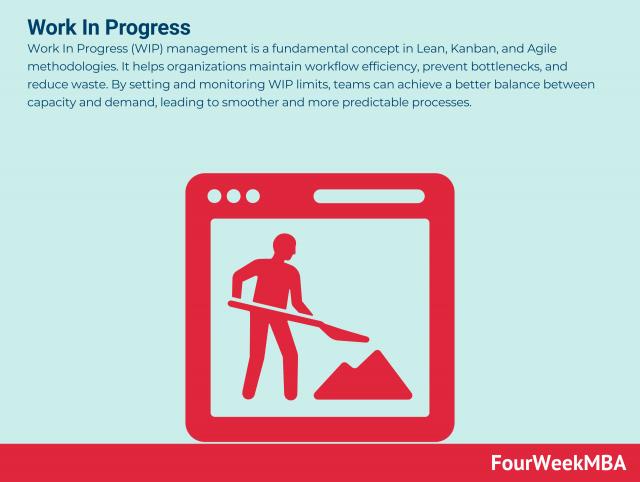Work In Progress (WIP) Management is a fundamental concept in Lean, Kanban, and Agile methodologies. It helps organizations maintain workflow efficiency, prevent bottlenecks, and reduce waste. By setting and monitoring WIP limits, teams can achieve a better balance between capacity and demand, leading to smoother and more predictable processes.
| Component | Work In Progress (WIP) | Analysis | Examples | Applications |
|---|---|---|---|---|
| Definition | The number of tasks or items actively being worked on at a given time within a workflow or process. | Helps manage workflow efficiency and prevent bottlenecks. | Limiting the number of tasks on a Kanban board to 5. | Effective task management in various industries. |
| WIP Limits | Predetermined constraints or thresholds on the maximum allowable WIP within a specific stage or column of a workflow. | Ensures teams focus on completing work rather than starting new tasks. | Setting a WIP limit of 3 tasks in the “In Progress” column. | Agile development, Lean manufacturing, project management. |
| Monitoring | Continuous tracking and visualization of WIP to ensure that it aligns with established limits. | Provides real-time insights into workflow health and identifies potential issues. | Using a Kanban board to track tasks and their status. | Agile teams, Kanban practitioners, manufacturing processes. |
| Pull Systems | WIP limits create a pull system where new work is only started when there’s capacity, based on WIP limits. | Promotes flow efficiency and reduces overburdening teams. | Kanban cards are pulled from the “To Do” column only when capacity allows. | Reducing work overload and maintaining steady progress. |
| Reducing Waste | By managing and limiting WIP, organizations can reduce waste caused by inefficiency, multitasking, and excessive work in progress. | Enhances productivity and minimizes lead times. | Identifying and addressing bottlenecks in a production line. | Lean manufacturing, agile software development, process optimization. |
In Agile methodology, managing Work in Progress (WIP) is crucial for maintaining a smooth workflow and optimizing productivity. WIP refers to the number of tasks or items actively being worked on at any given time within a team or process. Understanding the principles, benefits, challenges, use cases, and roles associated with WIP management is essential for Agile teams to effectively deliver value to customers. Let’s explore these aspects in detail:
Principles of Work in Progress (WIP) Management:
- Flow Optimization: Limiting WIP helps optimize the flow of work through the system, reducing bottlenecks and enhancing efficiency.
- Focus on Completion: By limiting the number of tasks in progress, teams can focus on completing work effectively before moving on to new tasks, reducing the risk of unfinished work.
- Visual Management: Visualizing WIP, such as using Kanban boards or task boards, provides transparency and clarity on the status of work, facilitating better coordination and decision-making.
Benefits of Managing Work in Progress (WIP):
- Reduced Cycle Time: Limiting WIP helps decrease cycle times, enabling faster delivery of value to customers and stakeholders.
- Improved Quality: Focusing on completing tasks before taking on new work reduces multitasking and context-switching, leading to higher-quality outcomes.
- Enhanced Predictability: With a clear understanding of WIP limits, teams can better predict and manage their capacity, leading to more reliable delivery timelines.
Challenges in Work in Progress (WIP) Management:
- Team Collaboration: Balancing WIP limits with the need for collaboration and flexibility within teams can be challenging, requiring effective communication and coordination.
- Changing Priorities: Adapting WIP limits to accommodate changing priorities or urgent requests while maintaining overall efficiency can present challenges in dynamic environments.
- Resistance to Change: Implementing WIP limits may face resistance from team members accustomed to a high volume of concurrent tasks, requiring change management and cultural adaptation.
Use Cases of Work in Progress (WIP) Management:
- Software Development: Agile software development teams use WIP limits to manage the number of features or user stories in progress, ensuring a steady flow of work through development stages.
- Manufacturing: In manufacturing processes, WIP limits help prevent overproduction and excess inventory by controlling the number of workpieces in various stages of production.
- Service Delivery: Service-oriented teams, such as customer support or professional services, use WIP limits to manage the number of open tickets or service requests, ensuring timely resolution and customer satisfaction.
Roles in Work in Progress (WIP) Management:
- Scrum Master: The Scrum Master facilitates the Agile process, including WIP management, by coaching the team on Agile principles and practices and removing impediments to workflow.
- Product Owner: The Product Owner prioritizes work items based on customer value and business priorities, collaborating with the team to ensure that WIP limits align with overall objectives.
- Team Members: Team members actively manage their individual WIP, focusing on completing tasks before taking on new work and collaborating with colleagues to maintain flow and efficiency.
Conclusions
In summary, effective management of Work in Progress (WIP) is essential for Agile teams to optimize workflow, deliver value to customers, and maintain high levels of productivity and quality. By adhering to principles such as flow optimization and visual management, overcoming challenges such as changing priorities, and leveraging roles such as the Scrum Master, Product Owner, and team members, organizations can successfully implement WIP management practices and drive success in Agile projects and initiatives.
Connected Agile & Lean Frameworks
AIOps
AgileSHIFT
Agile Methodology
Agile Program Management
Agile Project Management
Agile Modeling
Agile Business Analysis
Agile Leadership
Andon System
Bimodal Portfolio Management
Business Innovation Matrix
Business Model Innovation
Constructive Disruption
Continuous Innovation
Design Sprint
Design Thinking
DevOps

